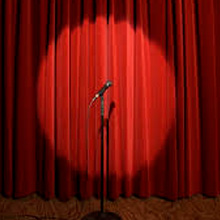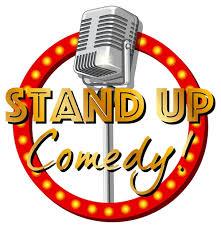
El stand-up Comedy tiene una larga historia. Durante el Renacimiento, los bufones reales eran elegidos por el rey, y él escogía a personas que lucían ridículas; tenían ojos saltones, espalda jorobada, eran bajos y a menudo deformes. Usaban ropa abigarrada (que no combinaba), y también usaban gorras y campanas, y llevaban cetros falsos con cabezas en los extremos para poder hablar con los cetros y no directamente con el rey. Debido a que estaban tan mal formados, se consideraba que no competían con el rey y, por lo tanto, se les permitía decirle cosas al rey que a nadie más se le habría permitido decir. Algunos bufones hablaban a través de cetros (hechos de vejigas de cerdo), como cuando los ventrílocuos de hoy hablan a través de sus títeres. Era una forma de “distanciarse” de las críticas. Incluso los comediantes actuales hablan por micrófonos, lo que al mismo tiempo empodera al comediante y lo distancia de la audiencia.
Desde el principio, los comediantes buscaron identificarse con etnias. Estos iban mucho más allá de las comunidades afroamericanas, hispanas y asiáticas. Escoceses, galeses, alemanes, noruegos, judíos e irlandeses eran motivo de broma, tanto dentro como fuera de los grupos. Todavía hoy vemos comediantes desesperados por destacar entre la multitud. Los “temas candentes” en las décadas de 1960 y 1970 fueron la política, las relaciones raciales y el sexo.
Alan King, Danny Thomas, Don Rickles, Joan Rivers y Jack Leonard se hicieron populares en clubes nocturnos y complejos turísticos, mientras que Woody Allen, Shelley Berman, Phyllis Diller y Bob Newhart se hicieron famosos en la televisión. Los comediantes afroamericanos Redd Foxx, George Kirby, Bill Cosby y Dick Gregory desarrollaron audiencias blancas. Lenny Bruce era conocido como "el" cómico obsceno, mientras que George Carlin fue arrestado en julio de 1972 después de interpretar su todavía famosa "Siete palabras que nunca podrás decir en televisión". En las décadas de 1980 y 1990, el stand-up se expandió desde los clubes nocturnos hasta convertirse en grandes conciertos con grandes audiencias. Bill Cosby y Steve Martin eran comediantes “gentiles”, mientras que Robin Williams era frenético. Richard Pryor utilizó un estilo mordaz, mientras que Rodney Dangerfield y Buddy Hackett mantuvieron el estilo antiguo, evitando la sátira social. Saturday Night Live y The Tonight Show llevaron el monólogo a todo el país. El editor de un periódico sugirió que los comediantes eran los nuevos “héroes” de nuestra sociedad.
HBO fue la primera cadena en producir comediantes sin censurarlos. Esto se debía en parte a que los clientes pagaban por sus servicios y esperaban más. HBO produjo 14 especiales de comedia protagonizados por George Carlin y su campaña contra la censura. Una nueva generación de comediantes, incluidos Bill Burr, David Cross, Hannibal Buress, Chelsea Handler, Dave Foley, Todd Glass, Sara Silverman y Demetri Martin, no tienen que preocuparse por la censura del tipo que provocó que los Smothers Brothers perdieran su programa porque de criticar levemente la guerra de Vietnam, o hizo que Jack Paar abandonara su programa para protestar por la censura por parte de su cadena de una vieja historia británica sobre una confusión sobre si W.C. significaba Wayside Chapel o Water Closet.
Se dice que Bob Hope, Jack Benny, George Burns, Fred Allen, Milton Berle, Henny Youngman, Alan King y Frank Fay ejemplifican una forma pura de comedia stand-up. Se pararon frente a una audiencia y lograron desarrollar el tipo de relación que les permitió hablar (y reír) con extraños que de repente se habían convertido en "amigos". Su actuación cómica es más teatral, más escrita, más elaborada y más desarrollada. Los artistas utilizan disfraces, accesorios y escenarios como lo hacen la mayoría de nuestros presentadores de televisión nocturnos contemporáneos.
(Este texto fue traducido al Español por by Google Translate)


By Don L. Nilsen
Standup Comedy has a long history. During the Renaissance, the royal jesters were chosen by the king, and he chose people who looked ridiculous; they had bug-eyes, and humped backs, and were short and often deformed. They word motley (mismatched) clothing, and they also wore caps and bells, and they carried fake scepters with heads on the ends of them so that they could talk to the scepters and not directly to the king. Because they were so mis-formed, they were considered not to be in competition with the king, and were therefore allowed to say things to the king that no one else would have been allowed to say. Some jesters spoke through scepters (made from pig bladders), as when today’s ventriloquists speak through their puppets. It was a way of “distancing” themselves from criticism. Even today’s standup comics speak into microphones, which at the same time empowers the comedian and distances the comedian from the audience.
Early on, comedians sought to identify themselves with ethnicities. These went way beyond African American, Hispanic, and Asian communities. Scotch, Welsh, German, Norwegian, Jewish, and Irish were all fodder for joking—both from inside and outside the groups. Still today we see comedians desperate to stand out from the crowd. “Hot topics” in the 1960s and 70s, were politics, race relations, and sex. Alan King, Danny Thomas, Don Rickles, Joan Rivers, and Jack Leonard became popular at nightclubs and resorts, while Woody Allen, Shelley Berman, Phyllis Diller, and Bob Newhart became famous on television. African American comedians Redd Foxx, George Kirby, Bill Cosby, and Dick Gregory developed white audiences. Lenny Bruce was known as ‘the’ obscene comic, while George Carlin was arrested in July of 1972 after performing his still famous “Seven Words You Can Never Say on Television.”
In the 1980s and 1990s, stand-up expanded from nightclubs into major concerts with huge audiences. Bill Cosby and Steve Martin were “gentle” comedians, while Robin Williams was frenetic. Richard Pryor used an acerbic style, while Rodney Dangerfield and Buddy Hackett stuck with the old style, avoiding social satire. Saturday Night Live and The Tonight Show brought stand-up comedy to the whole country. One newspaper editor suggested that stand-up comedians were the new “heroes” in our society.
HBO was the first network to produce comedians without censoring them. This was partly because patrons paid for their services and so expected more. HBO produced 14 comedy specials starring George Carlin and his campaign against censorship. A new generation of comedians including Bill Burr, David Cross, Hannibal Buress, Chelsea Handler, Dave Foley, Todd Glass, Sara Silverman, and Demetri Martin do not have to worry about censorship of the kind that caused the Smothers Brothers to lose their show because of mildly criticizing the Vietnam war, or caused Jack Paar to walk off his show to protest his network’s censoring of an old British story about a confusion over whether W.C. stood for Wayside Chapel or Water Closet.
Bob Hope, Jack Benny, George Burns, Fred Allen, Milton Berle, Henny Youngman, Alan King, and Frank Fay are said to exemplify a pure form of stand-up comedy. They stood before an audience and managed to develop the kind of rapport that allowed them to speak—and laugh—with strangers who had suddenly become “friends.” Their performance comedy is more theatrical, more scripted, more elaborate, and more fully developed. Performers use costumes, props, and stage settings as do most of our contemporary late night TV hosts.
